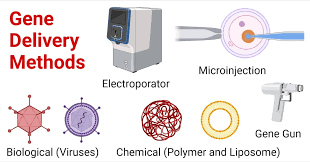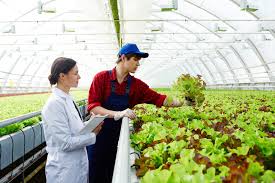There are four main steps in making a transgenic organism, the process being termed Transformation. There are several sources (donors) of this basic unit for genetic manipulation.
A gene can be taken from another variety of the recipient, from another species, genus or family, or even from another kingdom (animal, plant, fungi or bacteria).
As the nucleic acid of the gene is likely to be known, a gene can even be synthesized de novo (afresh) in the laboratory.
An important tool in the molecular biology “tool kit” for isolating genes and for assembling the elements that are introduced into recipient organisms are restriction endonucleases, also known as restriction enzymes.
These are enzymes that cleave the double-strand of DNA at specific sites, thus enabling the discrete isolation of a specific DNA sequence.
These specific pieces of DNA can be joined to other pieces in a directed manner using the enzyme DNA LIGASE.
Definition and components of the gene construct
The DNA that is introduced into plant cells during the process of transformation is termed a CONSTRUCT. A construct contains the DNA sequence conferring the trait, the DNA elements involved in expressing the gene (the promoter, terminator and any control sequences), and one or more SELECTION MARKER genes.
The DNA sequence conferring the trait can be either the gene of interest or DNA that transcribes to give RNA that is complementary to a sequence in the target organism; the latter is termed antisense RNA or RNAi and can induce a process called RNA silencing.
The selection markers are used to select the transformed cells from those that are not transformed, as the process of transformation can be inefficient. These DNA elements are assembled into one or more DNA molecules.
In some transformation strategies, the introduced construct comprises both the gene and the marker(s) on the same DNA molecule; in other transformation strategies (co-transformation), the gene and markers are on separate molecules.
Read Also: How to Grow, Use and Care for Whitetinge Sedge Grass (Carex albicans)
Amplification and cloning of the construct in bacteria

Having assembled the construct, amplification is needed to provide enough material to introduce into the plant cells. This is usually performed in bacteria by introducing the construct into a bacterial PLASMID; this is termed CLONING.
Various selection markers are used to select the transformed bacteria from the non-transformed bacteria. These include antibiotic resistance genes, which are of special significance in risk assessment.
There are approaches that do not involve antibiotic resistance markers, such as the blue-white colour selection method and herbicide-tolerant markers. Having isolated the gene, and having made and amplified the construct, it can be introduced into recipient cells.
Gene delivery and plant transformation procedure
The basic strategy for transforming a plant involves delivery of the construct(s) containing the gene(s) to the target material, selection of the transformed cells, and then regeneration of the transformed plant lines.
As noted above, the construct comprises an expression unit containing a selectable marker (which may be different from that used in the bacterium during the amplification stage) and an expression unit containing the gene of interest.
Read Also: How to Grow, Use and Care for Whitegrass (Leersia virginica)
Methods of gene delivery in agricultural biotechnology

There are three basic gene delivery systems, but only two are in general use for plant transformation. The most frequently used direct transfer method is BIOLISTICS, also known as the gene gun, where the construct DNA is coated onto small gold or tungsten particles which are then “shot” into the target cell material.
The most commonly used indirect transfer method involves Agrobacterium (Agrobacterium-mediated transformation).
Agrobacterium is a plant-pathogenic bacterium that contains a plasmid with the ability to insert part of its DNA into the chromosome of plants. For transformation of animals such as fish, the construct is usually microinjected into fertilized eggs.
Target materials used in plant genetic transformation
The constructs are then delivered into the target materials. Details of target materials differ between plant species and even between varieties of a species. One of the most important constraints is the ability to regenerate new plants from the target material, i.e. that the transformed cells have totipotency.
Thus, there is a wide variety of target materials, the most common being immature embryos and embryonic cell suspension (note that GUS = β-glucuronidase and GFP = green fluorescent protein, both being colour marker genes).
Other targets include meristems, protoplasts and even flowers. As noted above, eggs are frequently used recipient targets for animal systems.
Key biological definitions in plant and animal transformation
i. Totipotent: blastomeres that can develop into complete individuals when separated, or cells capable of forming any cell type.
ii. Blastomere: any one of the cells formed by the first divisions of a fertilized egg.
iii. Clone: a group of genetically identical individuals or cells derived from a single cell by repeated asexual divisions, or to produce a set of identical individual cells or DNA molecules from a single starting cell or molecule.
Gene integration and potential risks in agriculture
In most of the targets, the construct is inserted into nuclear DNA and hence is passed between plants during fertilization. This causes the potential risk of transgenes spreading from transformed to non-transformed plants or animals.
The chloroplasts of plants are usually inherited maternally and hence a transgene would not spread in pollen. Methods of chloroplast transformation are being developed which should mitigate some of the potential problems of gene flow.
This approach cannot be used with animals, which do not have chloroplasts. The development of mitochondrial transformation is in the very early stages both for plants and animals.
Selection of transformed cells in the transformation process
When the gene construct(s) have been delivered to the target, those cells into which there is actual integration of the input DNA have to be selected away from those that have not been transformed.
There is a range of selectable markers, which, as with the selection markers for the bacteria in which the constructs are amplified, are an important aspect of biosafety risk analysis.
Regeneration and evaluation of transgenic organisms
The final stages in the production of transgenic organisms are the regeneration of the transformed material. For plants, this can take a long time and requires much effort.
For animals, the transformed eggs are replaced into a suitable female or are cultivated in the laboratory. Then the transformed organisms have to be analysed; this will be discussed extensively during this article.
Each independently transformed individual is termed a transgenic event, and the individuals derived from a transgenic event are termed a transgenic line.
Do you have any questions, suggestions, or contributions? If so, please feel free to use the comment box below to share your thoughts. We also encourage you to kindly share this information with others who might benefit from it. Since we can’t reach everyone at once, we truly appreciate your help in spreading the word. Thank you so much for your support and for sharing!

